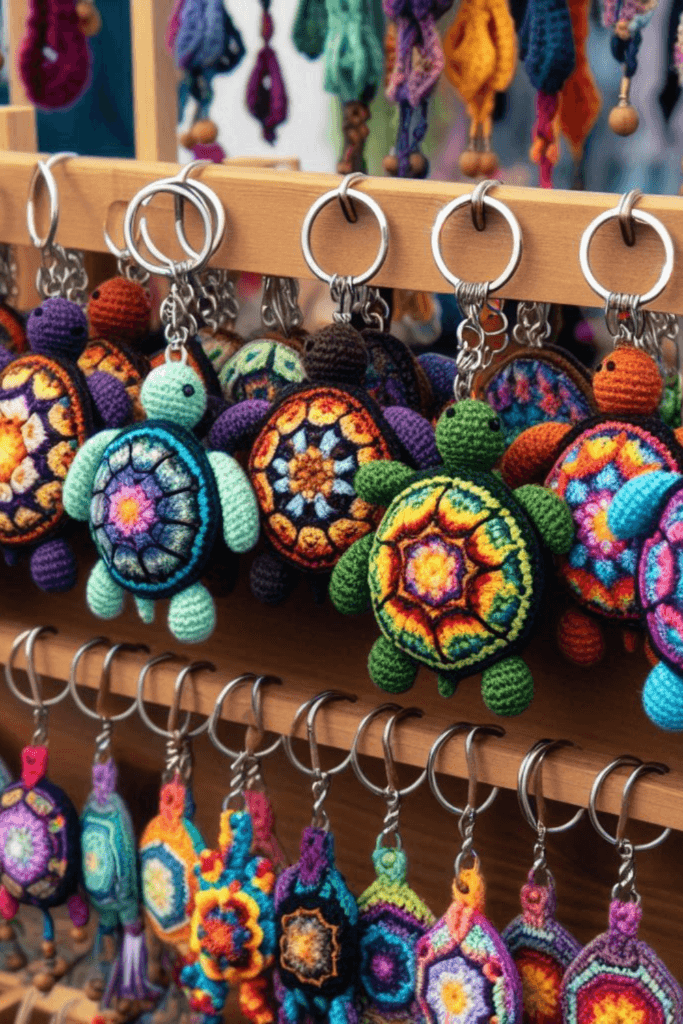Crochet Turtle Keychains. Crochet has long been celebrated for its versatility and creativity, with the ability to transform simple yarn into intricate and delightful creations. Among the various projects that crafters enjoy, crochet turtle keychains stand out for their adorable design and symbolic representation of endurance and wisdom. These tiny, handmade turtles not only make for a cute and practical accessory but also serve as a testament to the skill and patience of the crafter. In this comprehensive guide, we’ll explore the world of crochet turtle keychains, covering everything from essential materials to step-by-step instructions, and even tips for personalizing your designs.

The Appeal of Crochet Turtle Keychains
Turtles are universally beloved creatures, known for their slow and steady nature, making them a popular motif in various forms of art and craft. When crafted into keychains, these miniature turtles are not only functional but also serve as a cute, conversation-starting accessory.
Why Turtles?
Eco-Friendly Appeal: Using sustainable yarns, these keychains can also represent a commitment to eco-friendly crafting practices.
Symbolism: Turtles are often associated with longevity, perseverance, and wisdom, making them a meaningful choice for a keychain design.
Versatility: Crochet turtle keychains can be customized in various colors and patterns, making them suitable for all ages and styles.
Gathering Your Materials
Before starting your crochet turtle keychain, it’s crucial to gather the right materials. The quality and type of materials you choose will significantly impact the final look and feel of your keychain.
Basic Materials
- Yarn: A lightweight cotton or acrylic yarn works best for keychains. Choose colors that match your desired turtle design—green for a traditional look, or bright colors for a more playful appearance.
- Crochet Hook: A 2.5mm to 3.5mm hook is ideal, depending on the thickness of your yarn. A smaller hook will help create tighter stitches, which are essential for small projects like keychains.
- Stuffing: Polyester fiberfill is commonly used for stuffing the body of the turtle, giving it a firm yet squeezable feel.
- Safety Eyes: These small, secure eyes give your turtle a polished and professional look. Alternatively, you can embroider the eyes using black thread.
- Tapestry Needle: A needle with a large eye for sewing the different parts of your turtle together and weaving in the ends.
- Keychain Ring and Clasp: These are essential for turning your crochet turtle into a functional keychain.
Optional Materials
- Embroidery Thread: Useful for adding details like the turtle’s mouth or decorative patterns on the shell.
- Beads or Buttons: These can be added to the turtle’s shell for extra flair and personality.
- Felt: Small pieces of felt can be used for creating additional features like a soft belly or textured feet.
Step-by-Step Instructions for Crocheting a Turtle Keychain
Creating a crochet turtle keychain is a fun and rewarding project that involves several stages, from crocheting the body and shell to assembling and finishing the keychain.
Step 1: Crocheting the Shell
Start by creating a small, round shape using single crochet stitches. The shell can be made in one solid color or multiple colors for a more vibrant look. You can add texture to the shell by incorporating bobble stitches or other decorative techniques.
Step 2: Crocheting the Body
The body of the turtle is usually crocheted separately and then attached to the shell. It’s typically a slightly elongated oval shape, which will be stuffed with fiberfill before being sewn to the shell.
Step 3: Making the Head and Limbs
For the head, crochet a small, round shape and add safety eyes before closing it off. The limbs can be crocheted as small tubes or flat pieces and then sewn onto the body. Make sure they are proportional to the size of your turtle’s body.
Step 4: Assembly
Once all parts are crocheted, stuff the body and head with fiberfill and sew them together. Attach the limbs symmetrically to ensure the turtle sits evenly. Finally, sew the body to the shell, positioning it in the center for balance.
Step 5: Adding the Keychain Hardware
Attach a keychain ring or clasp to the top of the shell, making sure it’s secure. You can use a jump ring or simply sew the keychain directly onto the shell. Ensure that the attachment is sturdy enough to withstand daily use.
Design Ideas for Crochet Turtle Keychains
One of the joys of crocheting is the endless possibilities for customization. Here are some design ideas to inspire your crochet turtle keychains:
Classic Green Turtle
Use different shades of green for the body and shell to create a realistic-looking turtle. Add small details like a textured shell pattern or a contrasting belly color to enhance the design.
Rainbow Turtle
For a fun and vibrant keychain, use a rainbow-colored yarn for the shell. This design is particularly appealing to children and those who love bright, cheerful accessories.
Miniature Sea Turtle
Create a smaller version of a sea turtle with a streamlined body and flippers. Use blue or turquoise yarn for the shell and a darker color for the body to mimic the look of an ocean-dwelling turtle.
Festive Turtle
Customize your turtle keychain for different holidays or seasons. For example, use red and green yarn for a Christmas turtle or orange and black for a Halloween-themed design.
Turtle Family
Craft a set of turtle keychains in different sizes to represent a family. This can be a cute gift idea or a creative way to use up leftover yarn from other projects.
Tips for Crafting the Perfect Turtle Keychain
Creating small items like keychains requires precision and patience. Here are some tips to ensure your crochet turtle keychain turns out perfectly:
Maintain Tight Stitches
Using a smaller hook or maintaining a tighter tension will help your keychain hold its shape and prevent the stuffing from poking through.
Use Stitch Markers
Keeping track of your rounds and stitch counts is crucial in amigurumi. Stitch markers can help you stay on track and avoid mistakes.
Secure All Parts Firmly
When attaching the head, limbs, and other parts, make sure they are sewn on securely. This ensures the durability of your keychain, especially if it will be used frequently.
Experiment with Embellishments
Don’t hesitate to add personal touches like a tiny bow, glasses, or a little hat to your turtle. These small details can make your keychain unique and add to its charm.
Practice Makes Perfect
The more you practice, the more confident you’ll become in your crocheting abilities. Start with simple designs and gradually try more complex patterns as you improve.
Personalizing Your Crochet Turtle Keychain
Adding personal touches to your crochet turtle keychain can make it even more special. Here are some ideas for customization:
Monogramming
Use embroidery thread to add initials or a small name tag to your keychain, making it a personalized gift or a unique accessory for yourself.
Color Customization
Tailor the colors of your turtle to match your personal style or the recipient’s preferences. Whether you choose natural shades or bold hues, the choice is yours.
Adding Accessories
Incorporate tiny accessories like a mini scarf, hat, or even a pair of glasses to give your turtle a distinct personality. These additions can make your keychain stand out.
Gifting and Selling Crochet Turtle Keychains
Crochet turtle keychains make excellent gifts and are also popular items to sell at craft fairs or online. Here’s how to approach gifting and selling your creations:
Packaging
If you’re giving the keychain as a gift, consider packaging it in a small box or gift bag. Adding a handwritten note or a tag with care instructions can make the gift feel even more special.
Pricing Your Work
When selling, consider the cost of materials, the time spent crafting, and the uniqueness of your design. Handmade items often command higher prices due to their quality and individuality.
Marketing Your Keychains
Take clear, well-lit photos of your keychains for online listings. Highlight the details and craftsmanship to attract buyers. Use social media to showcase your work and connect with potential customers.
Choosing Sales Platforms
Etsy, craft fairs, and local markets are great places to start selling your crochet turtle keychains. Make sure to research your target market and choose platforms that align with your goals.
The Therapeutic Benefits of Crochet
Beyond the joy of creating something beautiful, crocheting can have profound benefits for your mental well-being. Engaging in a craft like crochet can help reduce stress, increase focus, and provide a sense of accomplishment.
Stress Reduction
The repetitive motion of crocheting is calming and can help reduce anxiety and stress. Many find the process meditative, providing a break from the hustle and bustle of daily life.
Enhanced Creativity
Working on crochet projects encourages creative thinking and problem-solving. Designing your own patterns or customizing existing ones can be particularly fulfilling.
Sense of Community
Joining crochet groups, either locally or online, can provide a sense of belonging and support. Sharing your creations and learning from others fosters a positive, creative community.
Joining the Crochet Community
Connecting with other crochet enthusiasts can be incredibly rewarding. Whether you’re seeking inspiration, looking to learn new techniques, or simply wanting to share your creations, the crochet community is welcoming and supportive.
Local Crochet Groups
Many cities have local crochet clubs or crafting groups that meet regularly. These groups are great for learning, sharing ideas, and making new friends who share your passion.
Online Forums and Social Media
Online communities like Ravelry, Pinterest, and various Facebook groups offer endless resources, patterns, and inspiration. You can also find video tutorials and live streams where experienced crocheters share their tips and tricks.
Craft Fairs and Markets
Attending craft fairs and markets can be an excellent way to meet other crafters, showcase your work, and even gain new customers if you’re selling your creations.
Expanding Your Crochet Repertoire
Once you’ve mastered the basics of crochet turtle keychains, you might want to explore other crochet projects. Here are some ideas to expand your crochet skills:
Amigurumi Animals
Dive deeper into the world of amigurumi by creating other animals like cats, dogs, or even mythical creatures. This will help you refine your skills and explore more complex patterns.
Home Decor
Consider crocheting items for your home, such as cushions, throws, or wall hangings. These projects can add a handmade touch to your living space and make great gifts.
Wearable Items
Explore crocheting wearable items like scarves, hats, or even clothing. These projects allow you to experiment with different yarns and techniques, expanding your crochet knowledge.
Conclusion
Crochet turtle keychains are more than just cute accessories; they are a testament to the creativity and craftsmanship of the maker. Whether you’re creating them as gifts, selling them at markets, or simply enjoying the process of making them, these little turtles offer endless possibilities for customization and expression. With a bit of yarn, a crochet hook, and your imagination, you can craft unique and charming turtle keychains that are sure to delight anyone who receives them. So why not pick up your crochet hook today and start creating your very own turtle keychain collection?
